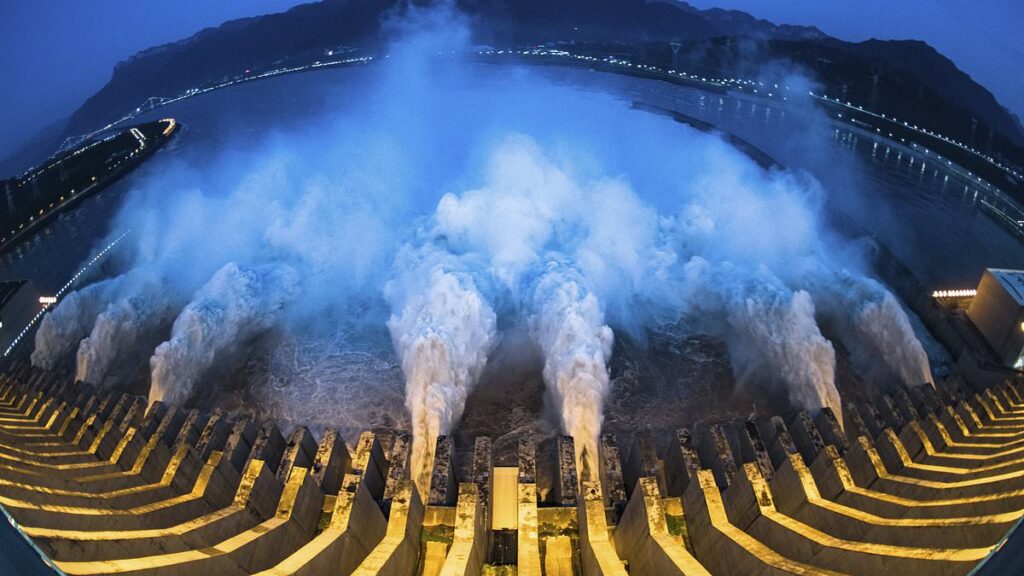
China has embarked on the construction of what is set to become the world’s largest dam, a project that promises to generate enough electricity annually to power the entirety of the United Kingdom. However, neighboring countries India and Bangladesh have expressed significant concerns, warning that the dam could be weaponized as a tool for “hydrowarfare.”
Chinese Premier Li Qiang inaugurated the construction of the Motuo Hydropower Station in a ceremony held in a remote Tibetan village. He hailed the project as the “project of the century.” The ambitious plan involves the installation of five cascading hydropower stations along a bend in the Yarlung Zangpo River, near the Namchabarwa mountain. Tunnels will be drilled through the rock to channel water into turbines, creating a massive energy source.
Strategic Concerns and Regional Impact
The dam, with a projected cost of 1.2 trillion yuan (approximately £124 billion), is expected to produce 300 billion kilowatt hours of electricity annually. This output is more than triple that of the Three Gorges Dam, currently the largest in the world. However, the Yarlung Zangpo River flows into the Indian states of Arunachal Pradesh and Assam, eventually reaching Bangladesh to form the Siang, Brahmaputra, and Jamuna rivers. These waterways are crucial for the agriculture and livelihoods of millions in one of the world’s most fertile regions.
Officials in India and Bangladesh have raised alarms, suggesting that the dam could enable China to control water flow across borders, potentially leading to devastating floods or droughts. Arunachal Pradesh’s Chief Minister Pema Khandu described the project as an “existential threat” to local livelihoods, warning that China could use the dam to create a “water bomb” during conflicts.
“The issue is that China cannot be trusted. No one knows what they might do,” Khandu stated, emphasizing the potential for catastrophic consequences if water were released suddenly.
Economic and Environmental Implications
Shares in China Energy Engineering, the project’s lead contractor, surged by 51% following the project’s launch, with other companies like Power China and Huaxin Cement also seeing significant gains. China’s foreign ministry has defended the project, asserting its necessity for achieving Beijing’s net-zero carbon goals by 2060. The ministry has dismissed previous complaints from India regarding pollution and has maintained that China has a “legitimate right” to develop the Yarlung Zangpo.
Despite these assurances, India remains unconvinced, having lodged formal complaints with China. The Indian government is developing the Siang Upper Multipurpose Project, a defensive dam intended to mitigate potential flooding from upstream water releases. However, neither China nor India is a signatory to the UN Water Convention, which regulates transboundary water management, leaving both nations free from legal obligations to ensure downstream water supply.
Historical Context and Future Risks
India, home to 17% of the global population but only 4% of its freshwater resources, views the control of water as a critical national security issue. A report by Australia’s Lowy Institute highlighted China’s strategic advantage over India’s water supply, while Neeraj Singh Manhas, a South Asia policy adviser, warned of China’s potential to “weaponize” water resources.
Political scientist Brahma Chellaney has pointed out the seismic activity in the Tibetan Plateau, suggesting that damming the Yarlung Zangpo could increase the risk of natural disasters, creating a “ticking water bomb.” Meanwhile, New Delhi’s recent suspension of the Indus Waters Treaty with Pakistan, following a terror attack, demonstrates the geopolitical leverage water resources can provide.
“Water wars are a key component of warfare,” Chellaney wrote, noting the potential for China to exploit its upstream position.
Environmental and Cultural Concerns
Previous Chinese megadam projects, such as the Three Gorges Dam, have had significant environmental and social impacts, including the displacement of 1.4 million people. Tempa Gyaltsen Zamlha, an environmental policy expert, has warned of similar consequences for the Yarlung Zangpo region, including ecological destruction and cultural displacement.
Brian Eyler, director of the Stimson Center’s energy, water, and sustainability program, cautioned against the dam’s potential to disrupt fish migration and sediment flow, vital for downstream agriculture. He emphasized the broader implications of such projects on regional stability and environmental health.
The construction of the Motuo Hydropower Station underscores the complex interplay of energy needs, environmental stewardship, and geopolitical strategy. As China advances with its plans, the international community watches closely, aware of the potential for water to become a central issue in future conflicts.







